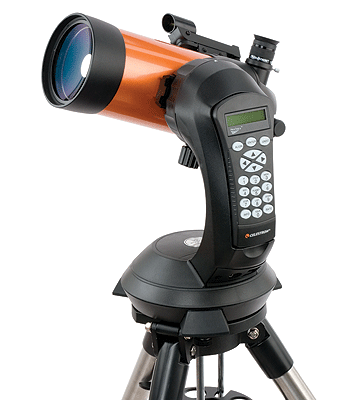Celestron
The company Celestron is one of the largest manufacturers of telescopes and accessories for amateur astronomy. The company's headquarters is Torrance, California, USA.
History
In 1950, the American Tom Johnson founded the company Valor Electronics in Torrance, California. Inspired by the construction of a telescope for his son, he founded in 1964 Celestron Pacific as part - owned by Valor and began in 1966 as the first producer in the world with the construction of Schmidt- Cassegrain telescopes (SCT ). As early as 1969 product range consisted SCT 6-22 inch opening. 1997 Celestron was sold to the competitors Tasco, 2001 Tasco Bushnell Optics, another telescope manufacturers.
2003 failed a hostile takeover by the direct competitors Meade, Celestron with which shared the market for SCT. Johnson bought back his company, after a U.S. federal court to sell to Meade, among others had forbidden because of monopoly.
Since 2005, Celestron is owned by an American subsidiary of Synta Optics, one of the world's largest optics manufacturer from Suzhou in China.
Range
Originally Celestron has professionally manufactured devices larger opening made , in particular with the Celestron C-12, C -16 and C-22 are to be mentioned. In addition, there were already in the 1960s, a C-4, C -6, C- 8 and C- tenth All these devices had a blue and white paint job. The numbers of these devices were invariably very low.
In the first half of the 1970s Celestron presented to its device program. The gray -orange devices now produced were less expensive and were produced in large quantities. Very successful and popular among amateur astronomers was and is the so-called Celestron C-8, an 8-inch Schmidt- Cassegrain telescope with a clear aperture of 200 mm and an aperture of f/10 (focal length 2000 mm), which in its quality and for the optical performance easy handling and transportability set standards, also remained affordable by the large numbers. Groundbreaking especially a patented process (U.S. 3,837,124 ), with the precision of the difficult ground of the Schmidt corrector plate by vacuum on a mold plate was machined and thus could be performed significantly less complex than before. SCT are characterized by very short overall length in relation to the focal length of (C -8: 40 cm ). The relatively thin and thus quickly auskühlende corrector plate is, however, thus directly on the Tubuseingang and is vulnerable to certain weather conditions against fogging with dew, so that superior Taukappen or ventilation may be necessary.
In the same construction as the C8 was the same C-5 ( hole 5 "= 125 mm ), and the C-14 (14" = 360 mm) on the market, it was followed by the C-11 (11 " = 280 mm), later a C-9 1/4 with 9.25 "and a C-6 with 6". a Celestron C-5 was the onboard telescope for research on various NASA shuttle flights. the first production series of the C- telescopes were bright orange ( " Celestron Orange" ) with light gray extensions. In the 1980s, an extension of the color palette followed on black or dark gray. the latest series " Edge HD" ( white tube) has an improved look which clearly a has less coma and the maximum design field curvature completely compensated.
As a substructure these telescopes in classical design is a very easy -to-use and extremely compact equatorial mount in the form of a fork mount ( without the need of counterweights ) with tracking by stepper motors of various designs. The optical tube can also be used on so-called German mounts with counterweights or altazimutalen systems without mechanical adjustment to the rotation of the earth, the latter sometimes we allow a computer-controlled tracking of the telescope to compensate for the Earth's rotation. Wide range of accessories makes the Celestron Schmidt- Cassegrain series a versatile product for a variety of applications (visual and photographic).
In contrast to classical Cassegrain telescopes, the SCT are not tagblind due to special interior panels, so that they can be not only astronomical, but also during the day, at about the observation of nature, is used. Another special feature is the inner focusing on the primary mirror, which (approximately 5 -fold) results in an exceptionally wide focus range along with the high post-magnification of the secondary mirror. Thus, the systems can be used as a " distance microscope " as opposed to traditional larger telescopes also for viewing the very near objects ( a few meters ), about the screen-filling observation of very small animals (eg insects or spiders) from problem-free distance. Also found in nature photography, the C- telescopes (some with reduced focal length, eg, C5 - Tele variant of 1250 mm to 750 mm reduced focal length) therefore widespread application. The typical inner focusing slight tilting of the optics in forward and backward driving of the mirror ( " shifting" ) is irrelevant to the image quality since the SCT primary mirror is spherical and is not parabolisiert. The compensation of the spherical shape error causes just the Schmidt corrector plate.
Today, the company produces mostly telescopes with fully automatic positioning also using GPS controlled engines; its look but further recourse to the tried and tested systems described above.










